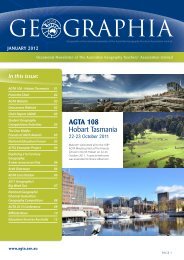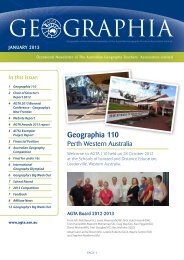Affiliate News - Australian Geography Teachers Association
Affiliate News - Australian Geography Teachers Association
Affiliate News - Australian Geography Teachers Association
Create successful ePaper yourself
Turn your PDF publications into a flip-book with our unique Google optimized e-Paper software.
Education Services Australia<br />
Malcolm welcomed<br />
Michael Gehling and Leanne<br />
Robinson from Education<br />
Services Australia.<br />
The key responsibility of Education Services<br />
Australia (ESA) is to provide curriculum<br />
and assessment materials, supporting<br />
the development of the new <strong>Australian</strong><br />
Curriculum.<br />
Education Services Australia (ESA) has<br />
recently launched SpatialGenie, an online<br />
education system to promote GIS in<br />
<strong>Australian</strong> schools. It is available for free<br />
use at http://www.spatialgenie.edu.au/<br />
spatialgenie/<br />
ACARA’s, Shape of the <strong>Australian</strong> Curriculum<br />
articulates the importance of the<br />
technology skills through the Information<br />
and communication technology (ICT)<br />
General Capability.<br />
Students develop ICT competence as<br />
they learn to use ICT effectively and<br />
appropriately when investigating, creating<br />
and communicating ideas and information<br />
at school, at home, at work and in their<br />
communities.<br />
The geography curriculum will provide<br />
many opportunities to develop and use<br />
ICT skills.<br />
These include basic computing skills and<br />
the use of computer software to locate,<br />
manage, analyse and present geographical<br />
information. Geographical ICT skills include<br />
the use and application of geographical<br />
information systems (GIS) and global<br />
positioning systems (GPS) management<br />
and representation of geographical data in<br />
graphical and other visual forms.<br />
The use of spatial technology is a rapidly<br />
growing area of ICT, with significant<br />
employment opportunities in the<br />
expanding spatial industry. The use of<br />
Registered Address<br />
503 Burke Road<br />
Camberwell South<br />
VIC 3124<br />
Postal Address<br />
PO Box 2066<br />
Camberwell West<br />
VIC 3124<br />
spatial technologies will be integrated into<br />
the curriculum from early primary school<br />
onwards to ensure the development of<br />
students’ ICT skills matches their cognitive<br />
abilities, and the application of those skills in<br />
the topics being studied. The curriculum will<br />
also provide opportunities for students to<br />
explore the effects of these technologies on<br />
places, the location of economic activities<br />
and on people’s lives, and to understand<br />
the changing spatial relationships enabled<br />
by ICT.<br />
ESA has morphed out of The Learning<br />
Federation, Curriculum Corporation and<br />
EDNA as the resource development arm<br />
of the <strong>Australian</strong> Curriculum initiative. The<br />
development of Spatial Genie by ESA is<br />
important because for the first time the<br />
education system in Australia, via ESA, has<br />
invested in the development and promotion<br />
of GIS in schools in a practical way.”<br />
When commenting on Spatial Genie<br />
Malcolm McInerney said that, “Irrespective<br />
of some of the platform problems, this<br />
development is especially important<br />
for the geographer wishing to use GIS<br />
in their classroom because of the data<br />
access function of the product. ESA has<br />
worked hard at acquiring data from<br />
government and private providers for use<br />
in SpatialGenie. Such a data bank acquired<br />
by a government organisation such as<br />
ESA is just what <strong>Australian</strong> geographers<br />
have been looking for to make data<br />
access, storage and configuration on a<br />
national scale a reality. In time Spatialgenie<br />
will also have data associated student<br />
activities and support materials integrated<br />
into the site.” (Accessed 22 October 2011<br />
on http://www.geospatialworld.net/<br />
index.php?option=com_content&<br />
view=article&id=22976:spatialgen<br />
ie-set-to-promote-gis-in-australianschools&catid=77&Itemid=1)<br />
GEoGrAPhiA<br />
AGTA<br />
Awards<br />
Early time-frame to be<br />
developed – finalised by the<br />
end of Term 3 and notified<br />
early Term 4 2012.<br />
SpatialGenie -Spatial data visualisation and<br />
analysis (http://www.spatialgenie)<br />
• A basic spatial analysis tool<br />
• Uses open source web mapping<br />
technologies<br />
• Access to real data<br />
• Incorporates data from government and<br />
organisations<br />
SpatialGenie as a tool provides:<br />
• Easier access to geospatial data and<br />
imagery<br />
• Excellent introduction for both students<br />
and teachers<br />
• Open- ended tool, exploratory in nature<br />
• For <strong>Australian</strong> schools this is well suited<br />
for Years 4-10<br />
Potential further developments:<br />
• Interactive, editable datasets (combines<br />
spatialgenie and datagenie(business<br />
intelligence data tool) strengths<br />
• Thematic maps<br />
• User interface improvements<br />
• Analysis tools, temporal and spatial<br />
dimensions






